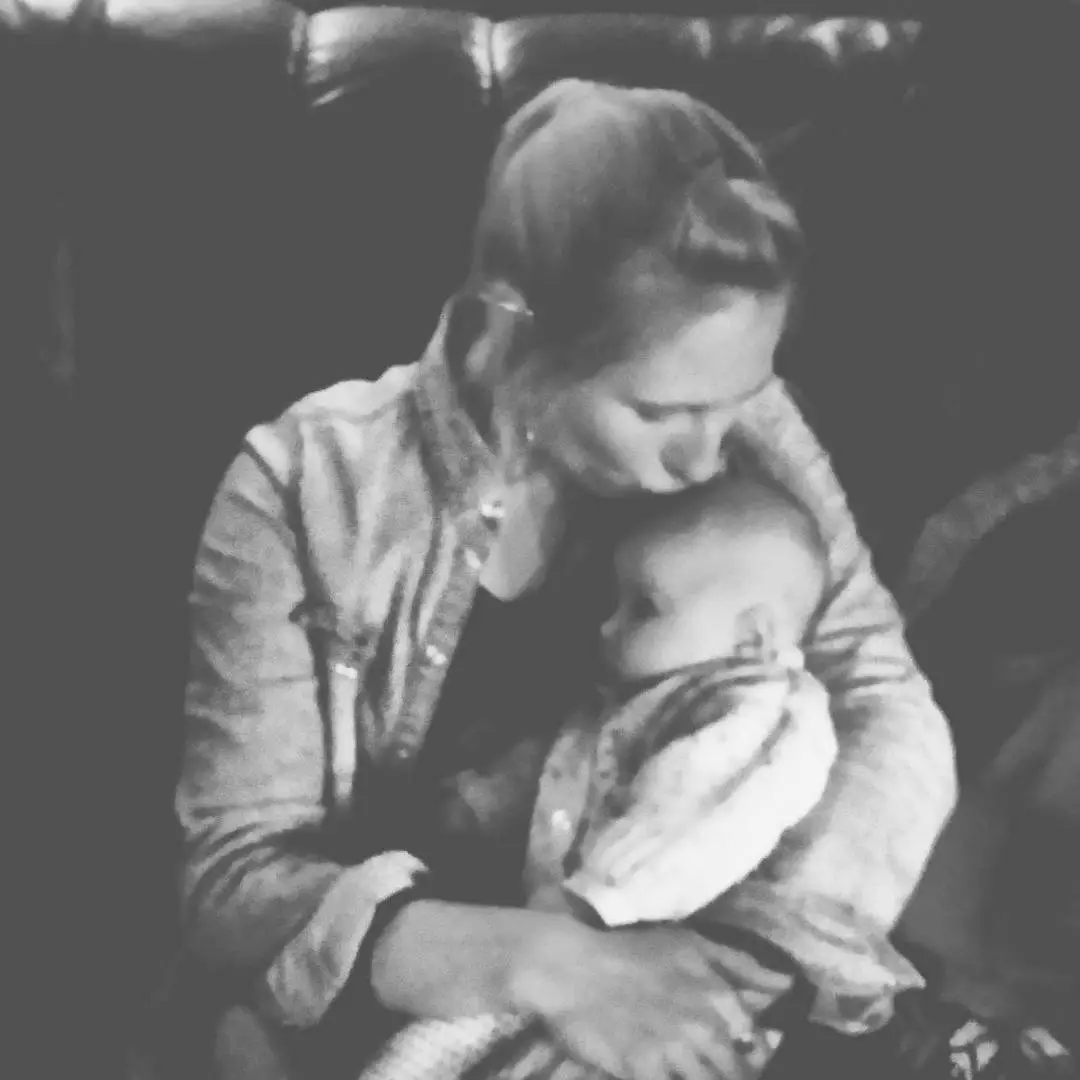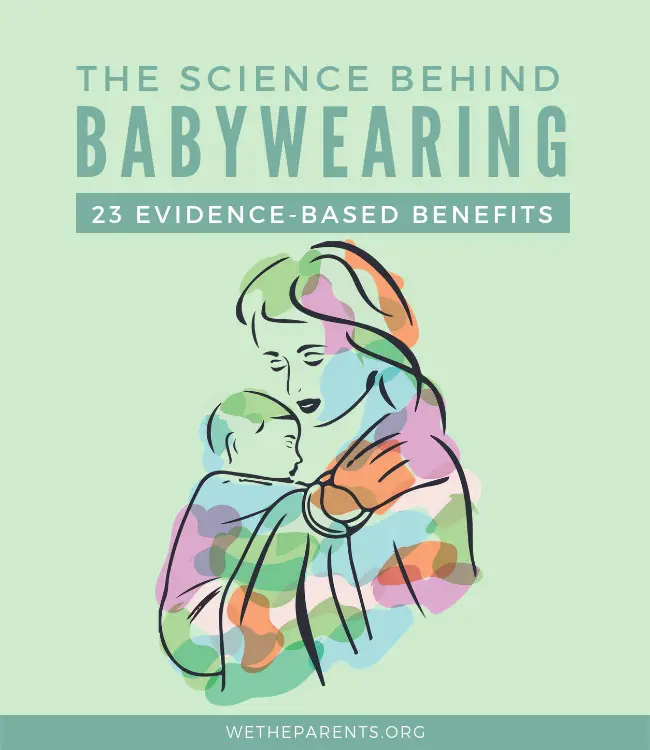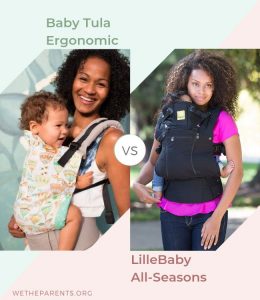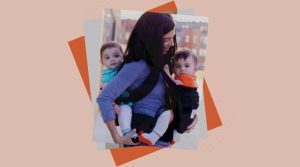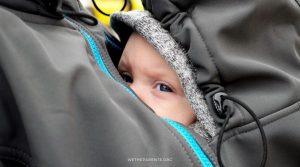For all of human history, babywearing was an ingrained part of childcare practices across continents and cultures. Then, a shift in attitudes occurred.
Particularly in the West, people started to believe that infants should learn how to self-soothe; mothers held or carried their babies far less throughout the day, and strollers became the default, convenient way to transport our little ones.
Just like that, wearing our babies seemed destined to become a footnote in motherhood history. Over the last few decades, however, the trend has been reversing. And, far from being some “crunchy mom” fad, babywearing is now entering mainstream health and social care practice.
One reason for this shift is that science is finally catching up with cultural wisdom and anecdotal evidence.
Let’s dive in and examine 23 compelling studies; each revealing an evidence-based benefit of using a baby carrier.
In this article:
Babywearing benefits [INFOGRAPHIC]

The science behind babywearing
Currently, there are only a handful of studies where researchers have directly measured the benefits of baby-carrying. They offer compelling results and advocates have long been calling for more.
But here’s the thing: to get a complete picture, we need to cast our net further.
There exists a wealth of compelling and highly relevant findings in closely related areas of study, such as early child development, Kangaroo Mother Care, and anthropology. It would be remiss not to include these in a discussion about babywearing.
Taken together, these studies provide a robust, science-backed case for carrying our babies.
Related: Baby Carriers vs. Wraps vs. Slings: An Easy yet Expert Guide

Examining the evidence
This round-up of 23 scientific studies showcases both direct baby-carrying research and also closely related studies in relevant fields. Here we present key findings:
1) Promotes secure mother-baby attachment
Let’s be honest; one day we all hope to have the kind of relationship with our kids that involves finishing each other’s sentences. The earlier we form a deep connection with our infants, the better off we are, and plenty of evidence points to babywearing as a way to foster such an attachment.
Forty-nine mothers from low socioeconomic statuses were divided into two groups. The first group, consisting of twenty-three mothers, received soft baby carriers (allowing for increased physical contact) while a control group of twenty-six moms was given infant seats.
At age thirteen months, all the babies took part in the Ainsworth Strange Situation, a manufactured scenario designed to see how a child would react to her mother’s absence.
Overall, the infants whose mothers had received soft baby carriers demonstrated a more secure maternal attachment than those who were given infant chairs.
Key study/paper:
Anisfeld E et al. (1990). “Does infant carrying promote attachment? An experimental study of the effects of increased physical contact on the development of attachment.” Child Development, 61(5):1617-27.
2) Baby cries less
As mothers, we hate to see our babies cry. Let’s face it; to avoid an unhappy child, we would happily do backflips. OK, maybe not happily, but you know what I mean. Luckily, you can save the theatrics for another day because according to the science, you do not need an elaborate acrobat routine to keep your little one happy.
Ninety-nine mother-infant pairs took part in a controlled study that looked at the link between crying and babywearing. Those assigned to the experimental group were instructed to hold their babies at random times, not just in response to crying, for an extra three hours a day.
The results showed that those infants, at six weeks old, cried 43% less overall, and 51% less at night, than the infants in the control group.
Key study/paper:
Hunziker UA, Barr RG. (1986). “Increased carrying reduces infant crying: a randomized controlled trial.” Pediatrics, 77(5):641-8.
Source: ncbi.nlm.nih.gov/pubmed/3517799
3) Aids baby’s healthy physical development
As moms, we are famous for scrutinizing every ingredient in the foods we feed our children, as well as constantly ensuring that they are nursing enough. We want our kids to grow up strong!
It turns out that the physical contact babywearing gives to our children can actually stimulate their growth, particularly in premature babies.
Studies have found that massage therapy, when applied with moderate pressure, led to increased weight gain in preterm infants and that even passive movement of the limbs increased both bone density and weight gain.
These are actions that wearing your baby can mimic; when worn, your child will receive a gentle pressure massage from your movements.
Key study/paper:
Field T et al. (2010). “Preterm Infant Massage Therapy Research: A Review.” Infant behavior & development, 33.2:115–124.
4) Makes mothers more responsive to baby
How many times have we wished our babies could open their mouths and tell us exactly what’s on their minds? As it turns out, you can actually make yourself more responsive to your child’s needs through touch.
A controlled study in which 23 mothers were given soft baby carriers, while 26 received car seats, demonstrated the positive effect of physical contact.
By analyzing a play session between mothers and their 3 1/2-month-old babies, researchers noted that mothers who had received a soft baby carrier were more in tune with the vocalizations coming from their babies than those who’d been using infant seats.
The conclusion was that a causal relationship possibly exists between increased physical contact and a more secure mother-baby bond.
Key study/paper:
Anisfeld E et al. (1990). “Does infant carrying promote attachment? An experimental study of the effects of increased physical contact on the development of attachment.” Child Development,61(5):1617-27.

5) Reduces reflux symptoms
Gastro-Esophageal reflux is a common occurrence among infants. While it usually resolves by itself, it is unpleasant, causes fussiness, and can, in some cases, lead to Gastro-Esophageal reflux disease (GERD).
The consequences of GERD can be as severe as respiratory illness, anemia, or failure to thrive. I guess we adults shouldn’t complain about the occasional acid reflux from a spicy dinner, right? Now for the good news.
When researchers monitored thirty-two infants in upright vs. lying down positions, they found that symptoms of Gastro-Esophageal reflux, including spitting up, coughing, and breathing problems, were reduced in frequency.
Since wearing your baby will keep them in that coveted upright position, thus allowing gravity to keep food in the stomach, you’ll find that your baby has fewer reflux symptoms throughout the day.
Key study/paper:
Jung WJ et al. (2012). “The Efficacy of the Upright Position on Gastro-Esophageal Reflux and Reflux-Related Respiratory Symptoms in Infants With Chronic Respiratory Symptoms.” Allergy, Asthma & Immunology Research, 4.1:17–23.
6) Helps depressed mothers to nurture their babies
If you are one of the countless mothers who suffer from depression, we first want to assure you that you’re not alone. Depression is an illness that goes beyond being tired or having a bad day; it is a medical condition for which you should never be afraid to seek help.
If you worry that your depression is affecting your infant’s development, then wearing your baby can be beneficial for you both.
One study observed forty-eight depressed and non-depressed mothers’ interactions with their babies and noted that there was a marked difference in how the infants responded to silent, expressionless parents.
When non-depressed mothers touched their babies wordlessly, with an impassive look on their faces, their infants appeared distressed. The children of depressed mothers who wore their babies, on the other hand, responded to the same silence and lack of facial expression with eye contact, babbling, and a smile.
This implies that, although the babies of depressed mothers were accustomed to a lack of verbal and/or facial emotion from them, they were still able to attribute her touch as a form of affection.
Key study/paper:
Peláez-Nogueras M et al. (1996). “Depressed mothers’ touching increases infants’ positive affect and attention in still-face interactions.” Child Development, 67(4):1780-92.
7) Improves breastfeeding rates
There was a time when many western countries seemed to forget that the breast is best. Luckily, breastfeeding is experiencing something of a renaissance in these areas of the world, and it seems that wearing your baby will help you keep up with those much-needed nursing sessions.
In one study, 100 women received both a soft baby carrier, with instructions to use it for at least 1 hour per day, along with information about breastfeeding. Another 100 women were not given a carrier to use but were given the same guidance regarding breastfeeding.
The women were contacted via phone when their infants were 3-months old, and again when they were 5-months old. Mothers who utilized their soft carrier reported significantly higher rates of breastfeeding than those who were not given a baby carrier.
While the results of this study are preliminary, and experiments involving self-reporting can lend themselves to criticism, it seems evident that babywearing, and its effect on breastfeeding rates, are worth continued investigation.
Key study/paper:
Pisacane A et al. (2012). “Use of baby carriers to increase breastfeeding duration among term infants: the effects of an educational intervention in Italy.” Acta Paediatrica, 101(10):e434-8.
Source: babywearing.co.uk/…/paper-on-use-of-slings-and-breastfeeding.pdf
Related: The Best Baby Wearing Shirts To Carry Your Baby
8) Soothes baby when distressed
Nothing makes a mother feel more like…well, a mom, than calming and soothing her distressed child. We all know, anecdotally, that rocking is a great way to quiet an upset infant, but one study set out to find an empirical link between this motion and its efficacy in calming babies.
Scientists examined thirty-six newborns, aged between 1 and 3 days. When distressed, the babies that were rocked by their mothers became pacified faster than those in a control group who did not receive any such intervention.
While this might not be surprising, the rocked babies also quieted more quickly than those who were picked up and merely held.
So what does rocking your baby and wearing your baby have in common? Simply put, these gentle, soothing motions that calm your child as you rock her are similar to those she’ll feel while being worn in a carrier or sling.
Key study/paper:
Byrne JM, Horowitz FD. (1981). “Rocking as a soothing intervention: The influence of direction and type of movement.” Infant Behavior and Development, 4:207-218.
Source: sciencedirect.com/science/article/pii/S0163638381800240…
9) Encourages wellbeing and relaxation in both mother and baby
Few things make us feel more bonded with another human than physical contact; touch is its own language of love, comfort, and safety. Virtually every mammal, at some point in their lifespan, will derive a significant benefit from the touch of their mother.
Even in rats (I’m going somewhere with this, I promise), warmth and touch have been shown to stimulate oxytocin release. In turn, cortisol and blood pressure levels decreased, thus producing an overall calming sensation in the animals.
Contact between mother and baby also provides emotional benefits in the field of safety and secure attachments.
Kerstin Uvnäs Moberg, who conducted the above study, has long championed the notion that a link between touch and oxytocin levels not only exists but that increasing oxytocin produces desirable effects.
Her research has played a significant part in pharmacological advancements that have gone on to aid people with conditions from autism to anxiety, illustrating that oxytocin is beneficial to humans.
Key study/paper:
Uvnäs-Moberg K. (1997). “Oxytocin linked antistress effects–the relaxation and growth response.” Acta Physiol Scand Suppl. 640:38-42.
Source: ncbi.nlm.nih.gov/pubmed/9401603
10) Baby spits up less
No one likes baby spit-up. It is just one of those things that we would love to avoid (we have enough laundry to do!), and it’s certainly not the most pleasant part of the day for our little one.
While it might seem like nothing can prevent the inevitable, it turns out that babywearing might be a useful technique in decreasing those reflux incidents.
One early study showed that even 10 minutes of extra touch and handling of our babies on a daily basis could lead to a significant reduction in the number of times they spit-up. Keeping our babies close through the use of a carrier or sling will certainly provide your infant with extra physical attention.
It will also allow your baby to remain in an upright position, something that’s recommended for 30 to 60 minutes after each of your little one’s meals.
Key study/paper:
Hopper HE, Pinneau SR. (1957). “Frequency of regurgitation in infancy as related to the amount of stimulation received from the mother.” Child Development. 28(2):229-35.
Source: ncbi.nlm.nih.gov/pubmed/13427073
11) Lowers risk of otitis media
While we’re talking stomach contents, did you know that those gastric fluids can cause your child to develop otitis media, also known as middle ear infection? One study tested 65 children who were about to have ear surgery for gastric juice in their middle-ears, with 59 children producing a positive sample.
The types of infections that can be caused by this fluid can lead to deafness, and their prevalence is shown to increase if your infant spends a lot of time lying on her back.
An easy way to limit your baby’s horizontal time during the day is by wearing her in a sling or carrier. This puts her in a vertical position, keeping those gastric juices down south where they belong while giving you the freedom to move about as you wish.
Key study/paper:
Tasker A et al. (2002). “Is gastric reflux a cause of otitis media with effusion in children?” Laryngoscope, 112(11):1930-4.
Source: ncbi.nlm.nih.gov/pubmed/12439157
12) Improves baby’s digestion
Digestion is important for everyone, and even more so for our infants. Our babies are growing rapidly, both physically and developmentally, and we owe it to them to give them every advantage — right down to how their little bellies are processing that breastmilk. So how to do that?
Well, as it turns out, wearing your baby actually mimics the feel of a gentle massage. Why is this good? One study has found that preterm infants who received massages experienced an increase in vagal activity.
While a low vagal activity level is thought to be linked to depression in infants, healthy levels have been found to stimulate gastric motility, or the movement of food through the digestive system, as well as helping with weight management among preterm infants.
Increased parasympathetic vagal activity can also stimulate the release of gastrin and insulin, hormones that aid food absorption.
Key study/paper:
Diego MA et al. (2007). ”Preterm infant massage elicits consistent increases in vagal activity and gastric motility that are associated with greater weight gain.” Acta Paediatrica, 96(11):1588-91.
Source: ncbi.nlm.nih.gov/pubmed/17888059

13) Eases transition into the world by mimicking womb
It’s not off base to say that birth, while a beautiful event, can be a culture shock for the new arrival. Unlike many other mammals, your baby does not emerge equipped to deal with this sudden change in scenery.
In fact, some scientists liken our young to kangaroos; too mature for the womb, yet too immature to survive outside their mother’s pouch.
Obviously, we do not have a pouch in which to put our babies as they grow, but keeping them close to our bodies can have a similar effect. The action of babywearing can mimic the warmth, ambiance, and sound of the womb.
Your little one will feel and hear your heartbeat, receive all the comfort of being swaddled, and will enjoy consistent, gentle movement. In wearing our babies, we give them a familiar, serene sensation, helping them adjust to their new world.
Key study/paper:
Gatts J D, “Infant environmental transition system and method”, US Patent, US5385153A.
Related: The Best Baby Carriers For Dads in 2021
14) Baby is less fussy
There are things apart from crying that can mean your baby is feeling fussy. She might appear restless, noisy, fidget a lot, or just seem generally discontent. However, these behaviors practically disappear when a baby is receiving attention.
One anthropological study conducted in Africa observed a marked difference between the members of a hunter-gatherer tribe, the Aka, and the Ngando people, who make their living as farmers.
While observational studies can impact the behavior of the subjects regardless of how careful the researchers are, scientists witnessed that the Aka held their babies continually, nursed often, and were quick to respond to signs of distress.
These babies, in turn, seemed to relax and rest more often than Ngando babies, who were not held as regularly. It’s a telling correlation that certainly deserves further study.
Key study/paper:Hewlett BS et al. (1998). “Culture and early infancy among central African foragers and farmers.” Developmental Psychology, 34(4):653-61.
Source: anthro.vancouver.wsu.edu/media/PDF/Culture_and_Early_Infancy1.pdf
15) Meets newborn’s need to be close to mother
It is no secret that your baby wants and needs to be close to her mother. And let’s face it, don’t we love to breathe in that new baby smell during a good snuggle session as often as we can? But, do the reasons for needing that closeness extend beyond an emotional response? The science points to a clear yes.
One randomized trial monitored the cries of newborns within the first 90 minutes of birth. Some were either skin-to-skin with their mother in a cot, with others in a cot for 45 minutes before returning to skin-to-skin contact with their mother.
Upon realizing they had been separated from their maternal caregiver, the babies began to cry but quieted when reunification occurred. Scientists believe this to be an instinctual “separation distress call”, a phenomenon occurring in many mammalian species as a way of restoring maternal proximity, and thus safety.
While baby carriers were not included as a group in this study, they do provide a consistent level of physical contact between a baby and her caregiver, suggesting that babywearing meets these biological needs of closeness.
Key study/paper:
Christensson K et al. (1995). “Separation distress call in the human neonate in the absence of maternal body contact.” Acta Paediatrica, 84(5):468-73.
Source: ncbi.nlm.nih.gov/pubmed/7633137
16) Humans are biologically adapted to carry their infants
The species of this planet have evolved to care for their newborns in several different ways, with three types of caregiving being the most common.
- Nest dwellers (aka cached): babies wait in a shelter that their parents have built and are cared for within its confines.
- Parent followers: babies are able to walk immediately after birth, the young belonging to this group rarely alone as they go wherever their mother goes.
- Carried young (aka parent clingers): these babies have evolved to be with their mothers via a clinging ability, some scientists believing we belong in this category.
Wait, you might think, my baby isn’t like an opossum or something like that! Well, it turns out that our infants might be more adept at holding on to us than we first thought. It is possible, with natural hip and leg movement, for babies to position themselves for maximum maternal contact.
Evelin Kirkilionis drew this conclusion when she compared the cream spread on an infant’s leg with the impression left on a mother’s dark shirt.
Her observation matched with existing research that found that a child was more than capable of making these clinging movements without impeding their hip development; suggesting that our bodies have evolved to grip onto our caregivers as infants.
While more study on humans and their relation to the Carried Young category is needed for more conclusive results, Kirkilionis’ work makes a fascinating argument in favor of babywearing being biologically natural.
Key study/paper: Nicolai K, (2013), “Cache or Carry? Comparative biology and infant carrying”. Published online.
Source: bindungtraegt.de/cache-or-carry-comparative-biology-and-infant-carrying/
17) Touch and motion physiologically calm baby
Happiness and contentment come from within, and I don’t just mean that in a mind-over-matter kind of way. We have all experienced the physiological symptoms of stress. Our heart can race, our stomach feels knotted, and, sometimes, we begin breathing too fast.
Naturally, we don’t want our little ones experiencing these bodily reflexes, as they’re most unpleasant. Fortunately, wearing our babies can diminish these physical signs of anxiety for them considerably.
A study has found that mouse pups experience a calming effect in response to their mothers carrying them. Not impressed? Well, that same study found an identical response among human babies!
It’s true; in both mouse pups and infants, researchers observed a slower heartbeat, decreased crying, and less movement among those carried by a walking mother over those held by a sitting mother.
They attribute this response to a coordinated set of central, motor, and cardiac regulations introducing a calming effect on babies.
Key study/paper:
Esposito G et al. (2013). “Infant calming responses during maternal carrying in humans and mice.” Current Biology, 23(9):739-45.
Source: ncbi.nlm.nih.gov/pubmed/23602481
18) May lessen postpartum depression
Postpartum depression is not as rare as we might imagine, and you’re certainly not alone if you suffer from it. As with depression, you should never be ashamed to seek help. You deserve to be as healthy as your baby needs you to be. On your journey back to wellness, you may discover that babywearing plays a crucial part in your recovery.
During one study, scientists asked 30 mothers who provided regular skin-to-skin contact with their newborns to report on their depression.
Compared to a control group of 60 mothers, who engaged in little, if any, skin-to-skin cuddling, mothers in the skin-to-skin contact group reported lower rates of depression after one week, then one month.
Mothers in this group also had a more significant reduction in their salivary cortisol levels after one month. While this study was not explicitly targeted at babywearing, its results suggest that the closeness of wearing your baby will positively impact your mental health.
Key study/paper:
Bigelow A et al. (2012). “Effect of mother/infant skin-to-skin contact on postpartum depressive symptoms and maternal physiological stress.” J Obstet Gynecol Neonatal Nurs., 41(3):369-82.
Source: ncbi.nlm.nih.gov/pubmed/22537390
19) Reduces risk of flat head
Evidence shows that an infant who rests on her back for extended periods, especially one who prefers a single head position, is at risk of developing flat head.
While sleeping on the back (on an appropriate mattress) is considered the safest way for a baby to sleep (it is thought to help prevent SIDS), that noggin needs a break during the day.
Wearing your baby enables infants to sleep and prevents them from continually being in one position. This provides a best-of-both-worlds scenario in which your baby gets their necessary nap without the risk of their skulls becoming malformed.
Key study/paper:
Mawji A et al. (2014). “Risk Factors for Positional Plagiocephaly and Appropriate Time Frames for Prevention Messaging.” Paediatrics & Child Health, 19.8:423–427.
20) Wearing a baby in a sling uses far less energy than carrying in-arms
With a baby in the house, you’ll probably be sleep deprived and busy; really busy. Conserving your energy is paramount as you forge your way through the jungle of parenthood.
Did you know that carrying your infant in your arms creates a burden16% greater than if you were wearing her on your body with a sling or other carrier? According to one study, carrying your baby could be a bigger energy burden than lactating!
Babywearing is a great way to avoid overexerting yourself as you go about your already hectic day.
Key study/paper: Wall‐Scheffler CM et al. (2007). “Infant carrying: The role of increased locomotory costs in early tool development”. American Journal of Physical Anthropology, 133(2):841-846
21) Synchronizes mother and baby biologically
We want our babies to feel as much a part of us as we do of them, even though there are times when we moms feel so overwhelmed that it’s a difficult emotion to exude. Good news! Babywearing can actually facilitate this sense of togetherness by literally syncing with baby, heart to heart.
One study involving mothers and their three-month-old infants noted that coordinated heart rhythms would occur during times of touch, with the phenomenon increasing exponentially when the interaction included vocalizing and facial expressions.
By wearing your baby in a front-carrying position, these interactions occur naturally and continually.
Key study/paper:
Feldman R et al. (2011). “Mother and infant coordinate heart rhythms through episodes of interaction synchrony.” Infant Behavior and Development, 34(4): 569-577.
Source: sciencedirect.com/science/article/pii/S0163638311000749
22) Supports physical growth in preterm infants
Any mother who has given birth to a preterm baby has experienced a fear unlike any other and wants to ensure their tiny newborns succeed at developmental growth. Babywearing can be the one thing you need from your mommy toolbox to accomplish this.
Researchers conducted a randomized controlled trial over 16 months that looked at the effect of Kangaroo Mother Care (KMC) vs. a standard incubator or open care system treatment on 488 preterm infants.
The 246 KMC babies were worn for at least 6 hours per day, along with plenty of skin-to-skin contact, and were found to grow and gain weight more successfully than the 242 infants in the control group.
It was concluded that Kangaroo Mother Care should begin as soon as possible and persist until the baby reached the 40 weeks of gestational age.
Key study/paper:
Tessier R et al. (1998). “Kangaroo mother care and the bonding hypothesis.” Pediatrics,102(2):e17.
Source: ncbi.nlm.nih.gov/pubmed/20667921
23) May increase mothers’ resilience and parental confidence
We’re not saying that you will never have another case of the ‘mommy jitters’ if you wear your baby, but evidence suggests that babywearing along with skin-to-skin contact can make you feel more confident when dealing with stressful situations involving your baby’s health.
In one experiment involving 488 infants, researchers set out to study what, if any, impact that skin-to-skin contact in a kangaroo-carrying position had on bonding levels.
They found that those maternal caregivers who engaged in Kangaroo Mother Care reported a stronger sense of competency when their at-risk infants required longer hospitalization than did those in the control group.
Key study/paper:
Gathwala G et al. (2010). “Effect of Kangaroo Mother Care on physical growth, breastfeeding and its acceptability.” Tropical Doctor, 40(4):199-202
Source: ncbi.nlm.nih.gov/pubmed/9685462
Related: The Best Twin Carriers Of 2021
Babywearing benefits that we don’t need science to prove
Okay, so scientific data is important and facts help us make good choices. But it would be foolish to ignore cultural wisdom and anecdotal evidence when considering the benefits of babywearing. The best advice and most pertinent truths are often gained by simply asking other parents about their personal experience.
That said, here are some benefits that don’t need ‘confirmed’ by science. Babywearing can:
- Enable you to be more productive;
- Allow you to travel with ease;
- Be economical;
- Make breastfeeding in public a snap;
- Facilitate easier vaccination appointments as your baby can be instantly comforted;
- Help other caregivers have baby-bonding time;
- Provide safety for your baby when out and about;
- Allow you to monitor your baby closely;
- Promote face-to-face contact with your infant;
- Be a boatload of bonding and fun!
Wearing your baby in the safest way
Let’s talk safety. As with all things baby-related, it’s vital to choose a product that is appropriate for you and your child. Having done that, be sure to read and follow all instructions included with your chosen sling or carrier. Meanwhile, here are some general safety tips to keep in mind.
The T.I.C.K.S rule for safe babywearing
Baby sling safety
- To avoid a suffocation hazard, use only a sling that has been made specifically for newborns, or wait until they are 4+ months of age before using one;
- Check your baby frequently;
- Make sure they have a clear airway at all times;
- When bending, use your waist and do not bend at the knees;
- After nursing, be sure to reposition your baby, so their head is facing upwards and away from your breast and any fabric;
- Regularly inspect your sling for wear and tear;
- Practice putting your sling on properly before carrying your baby;
- Make sure your sling offers appropriate head and neck support for your baby
Baby carrier safety
- Regularly check that your infant’s airway is clear;
- Practice baby carrying with a ‘spotter’ and/or over a bed or couch until you are confident in your technique;
- Be sure that your carrier offers adequate head and neck support for your infant;
- Pick a wide-based carrier;
- Only use outward facing positions for short periods of time and always face baby inwards when asleep.
Editor’s Note:
There is some debate about whether or not “narrow-base” carriers that allow your baby’s legs to dangle downward may be harmful. Babywearing expert, Dr. Rosie Knowles, provides an excellent summary of these issues, and says “using a narrow-based carrier will not harm the majority of children”. However, for babies that may have undiagnosed mild Developmental Hip Dysplasia, they will benefit from wider-based carriers that “promote the flexed, abducted spread-squat position that seems to encourage better hip joint positioning and deeper development of the socket.” So, bottom line: narrow-based carriers are probably fine for most children, but if you want to play it safe, then a wider-based carrier (properly used) encourages the hip joints to be held in the optimal position, with no weight at all dragging down on the joint. Rosie advises parents to use wider-based carriers.
https://www.carryingmatters.co.uk/healthy-hips-busting-some-myths/
Where applicable, be sure to register all baby carrying devices, as you can then be alerted to any recalls.
Wrapping up
While once on the verge of extinction, babywearing is now making a comeback among parents and scientists alike.
The research is clear. Slings and carriers provide your baby with emotional benefits, such as allowing her to feel safe and bonded, along with the physical advantages of lessening the chance of baby developing flat head, and controlling reflux issues.
These products also provide you, the parent, with some great perks. Who doesn’t want to conserve their energy and be more productive while, simultaneously, bonding with their infants?
With our babies on our bodies and science by our side, the future of babywearing certainly looks bright!

